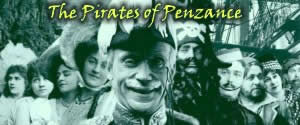You are here: > > Glossary
GLOSSARY
Act I.
Bumper: A cup or glass filled to the brim.
Scuttling a Cunarder: Sinking a passenger ship of the Cunard line.
Cutting out a P&O: Separating a passenger ship of the Peninsular and Orient line from other ships in the fleet in order to capture it.
Handspike: A lever, generally made of wood, which is fitted into a windlass or capstan to heave up an anchor or heavy chain.
On breakers always steering: Always making mistakes and getting into trouble; as when steering a ship toward waves breaking on rocks.
Black flag: The skull and cross bones, Jolly Roger.
Custom House: The officers of Her Majesty’s Department of Customs and Excise.
Glass: Barometer (rising indicates fair weather).
Caravanserai: A word of Persian origin meaning a quadrangular inn with a great inner court where caravans put up.
Wards in Chancery: Minors under the protection of the Court of Chancery.
Battle of Marathon: 490 B.C. the Greeks defeated the Persians at Marathon.
Battle of Waterloo: 1815. Wellington defeated Napoleon.
Equations, simple and quadratical: A simple equation does not involve the second or any higher power of the unknown. A quadratic equation involves the second power.
Binomial Theorem: Formula for finding any power of a binomial (two terms connected by + or -) without having to multiply it out at length.
Hypotenuse: The longest side of a right angled triangle. The Theorem of Pythagoras' states that the square of the Hypotenuse is equal to the sum of the squares on the other two sides.
Integral and differential calculus: Integral calculus is a method for finding the sum of small quantities. Differential calculus is a method for determining rates of change.
Animalculous: An animalcule is a microscopic animal.
Acrostics: A popular Victorian parlour game similar to charades, in which players had to guess one word answers to acted-out clues. The first letters of these then spell out the final answer.
Elegiacs: The classical verse form of alternating hexameters and pentameters in which elegies were written.
Heliogabalus: Probably the most dissolute of the Roman emperors who ruled from 218 A.D. to 222 A.D.
Conics: The study of curves, such as circles, ellipses, hyperbolas and parabolas, formed when a cone is cut by a plane.
Floor: Defeat.
Parabolous: More usually “parabolic”. Like a parabola.
Raphaels: Paintings by the Italian Renaissance painter Raffaello Sanzio (1483-1520), better known as Raphael.
Gerard Dows: Paintings by Gerard Dou (1613-75), a pupil of Rembrandt.
Zoffanies: Paintings by Johann Zoffany (1735-1810), a German portrait painter who settled in England.
"The Frogs" of Aristophanes: Perhaps the best known comedy by the Greek playwright Aristophanes (c.445-385 B.C.). The croaking chorus goes "Brekekekex, ko-ax, ko-ax").
Washing-bill: Laundry list.
Babylonic cuneiform: The script of the ancient Babylonians, so called because of its wedge shaped letters.
Caractacus's uniform: Caractacus is the Roman name for the British chief Caradoc who fiercely resisted the Romans after their invasion of Britain in 43 A.D. John H. Foley's 1859 sculpture of Caractacus in front of London's Mansion House suggests that "Caractacus's uniform" was little more than a loin-cloth.
Fugue: Polyphonic composition in which a short melodic theme is introduced by one part and taken up by the others.
Pinafore: A reference to Gilbert and Sullivan’s previous show which had been a great success both in Britain and America.
Mamelon: An earthwork in the form of a rounded mound suitable for use in an ambush or sniping attack.
Ravelin: A detached outwork, outside the main ditch of a fort.
Mauser Rifle: A rifle developed for use by the Prussian Army in the early 1870s.
Commisariat: The provisioning branch of the Army.
Sorties and surprises: Sudden movement of besieged troops upon the besiegers.
Sat-a-gee: Ridden a horse, "gee-gee" being a childish name for a horse.
Emollient: An ointment that softens the skin, but here used figuratively.
Dimity: A stout cotton cloth, ribbed and figured.
Act II.
Stucco: A fine plaster used as a coating for walls or internal decorations.
Escutcheon: Shield displaying heraldic insignia; the family crest.
Emeutes: A French term for riots or brawls.
Felon: One who has committed a felony such as murder or burglary.
Coster: Costermonger, street vendor of fruit, fish, etc.
Centrebit: A carpenter's boring tool.
Life preserver: A stick or bludgeon loaded with lead, intended for self-defence.
Silent matches: Matches made by coating wooden sticks with sulphur and tipped with chlorate of potash which were ignited by dipping them in a bottle of asbestos and sulphuric acid and so ignited silently.
Skeleton(ic) keys: A key fitting many locks by having the interior of the bit hollowed.
Unshriven: Without having made confession and receiving absolution.
Unannealed (unaneled): Without having been anointed. Part of the last rites, administered to a dying person in the Roman Catholic church is anointing with oil.
Mien: Demeanour, bearing, outward behaviour.
Central Criminal Court: The Old Bailey, the major criminal court in the land since 1834.
House of Peers: The House of Lords, the upper house of the British Parliament.
|
Page modified 3 November 2008
